
How to Use 8 Channel 5v Relay: Examples, Pinouts, and Specs
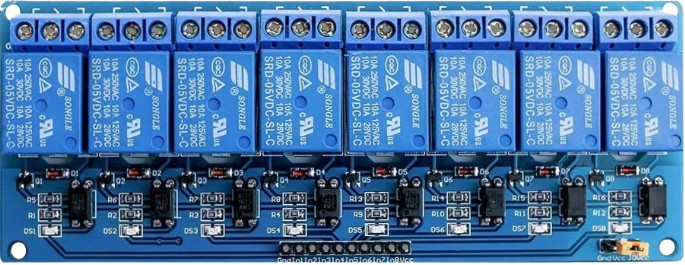
 Design with 8 Channel 5v Relay in Cirkit Designer
Design with 8 Channel 5v Relay in Cirkit Designer8 Channel 5V Relay Module Documentation
Manufacturer: AC
Part ID: Relay
1. Introduction
The 8 Channel 5V Relay Module is a versatile electronic component designed to control high-voltage devices using low-voltage signals, typically from a microcontroller such as an Arduino UNO. Each of the 8 relays on the module can independently switch devices on or off, making it ideal for automation, home control systems, and industrial applications.
Common Applications:
- Home automation (e.g., controlling lights, fans, or appliances)
- Industrial control systems
- Robotics and IoT projects
- Smart agriculture systems
- Security systems (e.g., controlling alarms or locks)
This module is particularly useful for projects requiring the control of multiple high-power devices with a single microcontroller.
2. Technical Specifications
Key Technical Details:
| Parameter | Value |
|---|---|
| Operating Voltage | 5V DC |
| Trigger Voltage | 3.3V to 5V (compatible with most microcontrollers, including Arduino) |
| Relay Channels | 8 |
| Maximum Load (AC) | 250V AC @ 10A |
| Maximum Load (DC) | 30V DC @ 10A |
| Isolation | Optocoupler isolation for each channel |
| Indicator LEDs | Yes (one LED per channel to indicate relay status) |
| Dimensions | ~138mm x 56mm x 18mm |
| Weight | ~120g |
Pin Configuration and Descriptions:
Input Pins (Control Side):
| Pin Name | Description |
|---|---|
| VCC | Connect to 5V DC power supply (powers the relay module). |
| GND | Ground connection. |
| IN1 - IN8 | Control pins for each relay channel. A LOW signal activates the corresponding relay. |
Output Pins (Relay Side):
Each relay has three output terminals:
| Terminal | Description |
|---|---|
| NO (Normally Open) | The device is disconnected when the relay is inactive. Connect the load here if you want it to turn ON when the relay is activated. |
| NC (Normally Closed) | The device is connected when the relay is inactive. Connect the load here if you want it to turn OFF when the relay is activated. |
| COM (Common) | Common terminal for the relay. Connect the power source or ground of the load here. |
3. Usage Instructions
Connecting the Relay Module to an Arduino UNO:
Power the Module:
- Connect the
VCCpin of the relay module to the 5V pin on the Arduino UNO. - Connect the
GNDpin of the relay module to the GND pin on the Arduino UNO.
- Connect the
Control Pins:
- Connect the
IN1toIN8pins of the relay module to the desired digital pins on the Arduino UNO. For example, you can connectIN1to pin 2,IN2to pin 3, and so on.
- Connect the
Load Connections:
- For each relay, connect the load (e.g., a light bulb or motor) to the
NOorNCterminal, depending on whether you want the load to be ON or OFF by default. - Connect the power source for the load to the
COMterminal.
- For each relay, connect the load (e.g., a light bulb or motor) to the
Code Example:
Below is an example Arduino sketch to control the relays:// 8 Channel Relay Control Example // This code demonstrates how to control an 8-channel relay module // using an Arduino UNO. Each relay is toggled ON and OFF sequentially. // Define the relay control pins const int relayPins[8] = {2, 3, 4, 5, 6, 7, 8, 9}; void setup() { // Initialize all relay pins as OUTPUT for (int i = 0; i < 8; i++) { pinMode(relayPins[i], OUTPUT); digitalWrite(relayPins[i], HIGH); // Set all relays to OFF initially } } void loop() { // Sequentially turn each relay ON and OFF for (int i = 0; i < 8; i++) { digitalWrite(relayPins[i], LOW); // Turn relay ON delay(1000); // Wait for 1 second digitalWrite(relayPins[i], HIGH); // Turn relay OFF delay(1000); // Wait for 1 second } }
Important Considerations:
- Power Supply: Ensure the relay module is powered with a stable 5V DC supply.
- Isolation: The module uses optocouplers for isolation, but additional precautions should be taken when working with high voltages.
- Load Ratings: Do not exceed the maximum load ratings of the relays (250V AC @ 10A or 30V DC @ 10A).
- Signal Logic: The relays are activated with a LOW signal (0V) on the control pins.
4. Troubleshooting and FAQs
Common Issues and Solutions:
| Issue | Possible Cause | Solution |
|---|---|---|
| Relays not activating | Insufficient power supply | Ensure the module is powered with a stable 5V DC source. |
| Relays activate randomly | Electrical noise or interference | Use decoupling capacitors or shield the module from interference sources. |
| Load not turning ON/OFF | Incorrect wiring of the load to the relay terminals | Double-check the connections to the NO, NC, and COM terminals. |
| Arduino resets when relays activate | Power supply cannot handle the current surge | Use a separate power supply for the relay module. |
Frequently Asked Questions:
Can I use this module with a 3.3V microcontroller (e.g., ESP32)?
Yes, the module is compatible with 3.3V logic levels, but ensure the relays are powered with 5V.Can I control AC and DC loads simultaneously?
Yes, as long as the total load does not exceed the relay ratings.Do I need external flyback diodes for the relays?
No, the module already includes flyback diodes to protect against voltage spikes.Can I use fewer than 8 relays?
Yes, you can use only the relays you need. Leave the unused control pins unconnected.
This documentation provides a comprehensive guide to using the 8 Channel 5V Relay Module. Whether you're a beginner or an experienced user, this module is a reliable choice for controlling multiple devices in your projects.
Explore Projects Built with 8 Channel 5v Relay
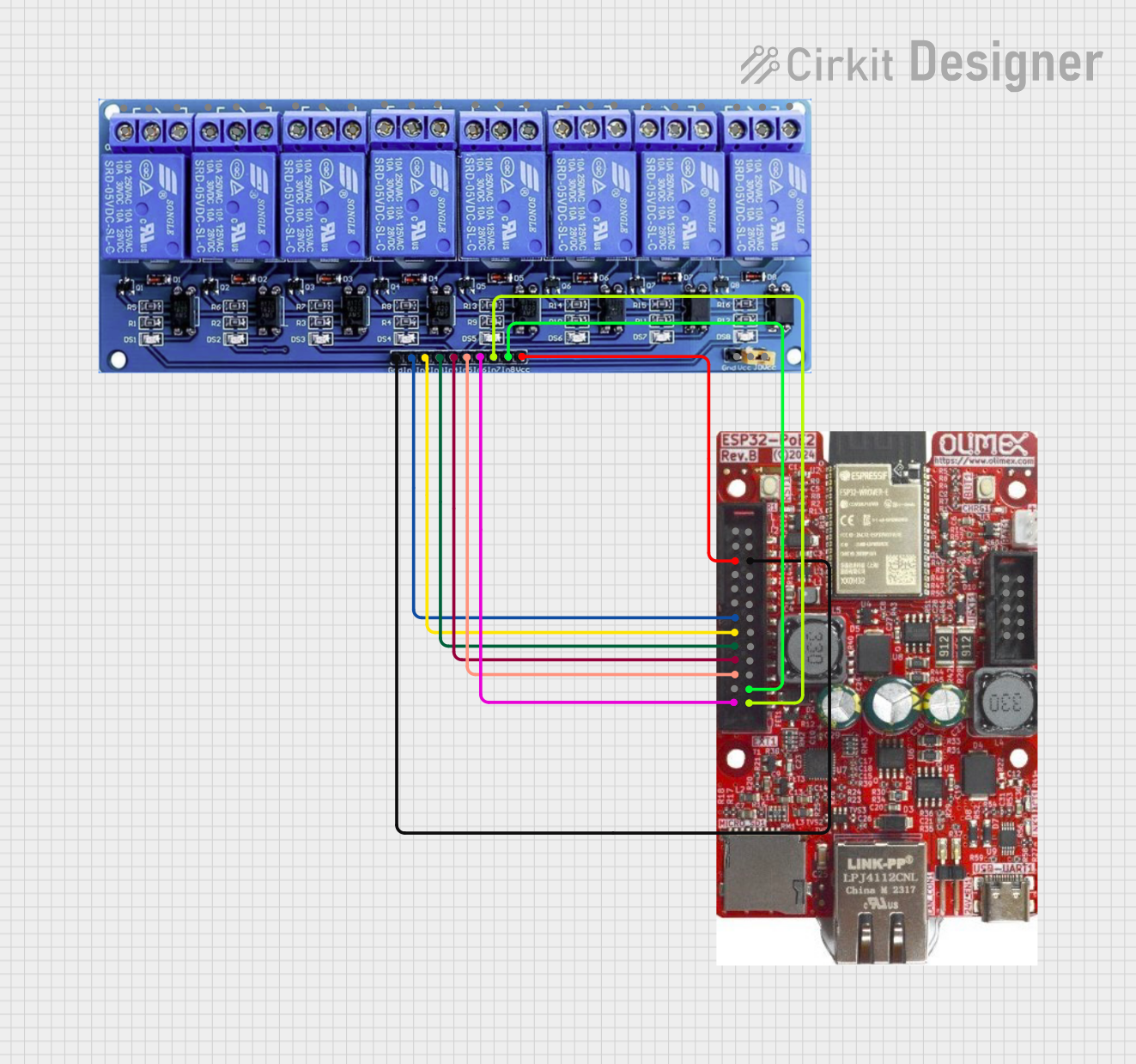
 Open Project in Cirkit Designer
Open Project in Cirkit Designer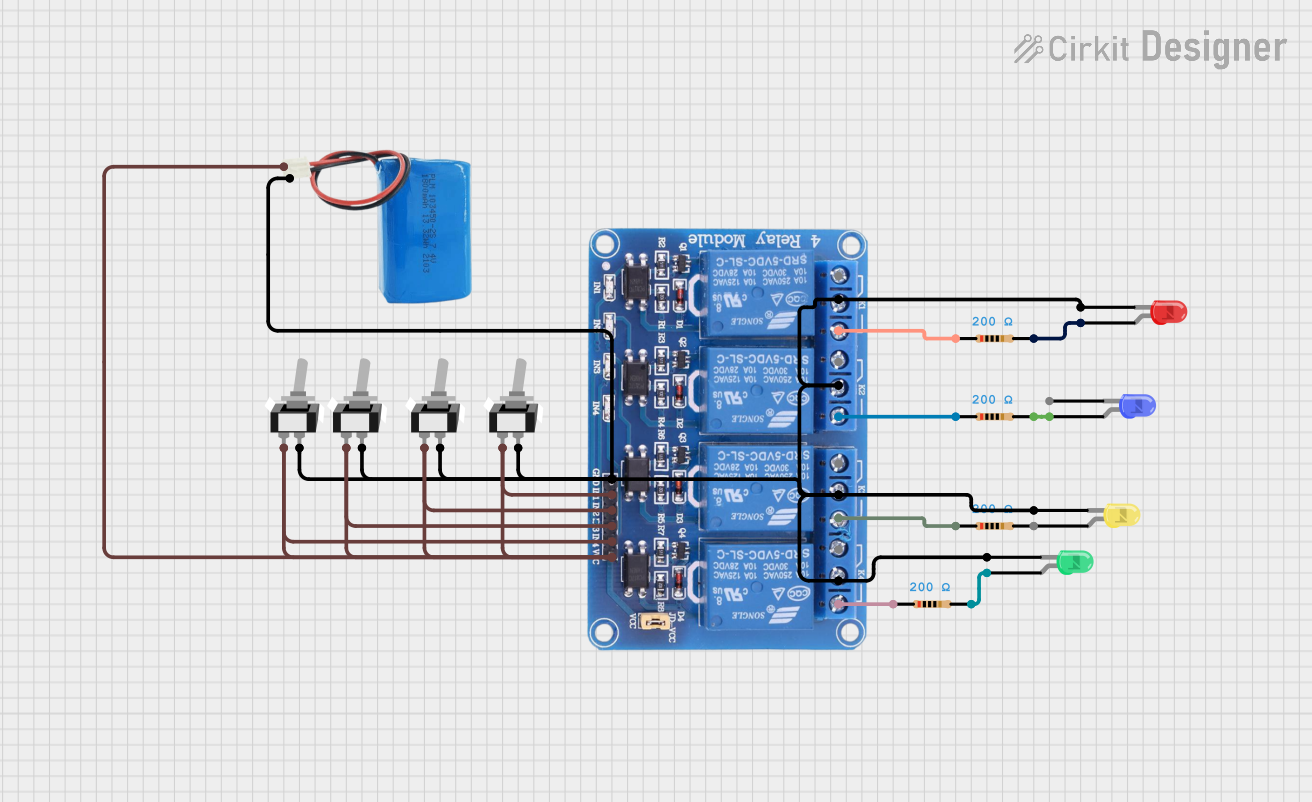
 Open Project in Cirkit Designer
Open Project in Cirkit Designer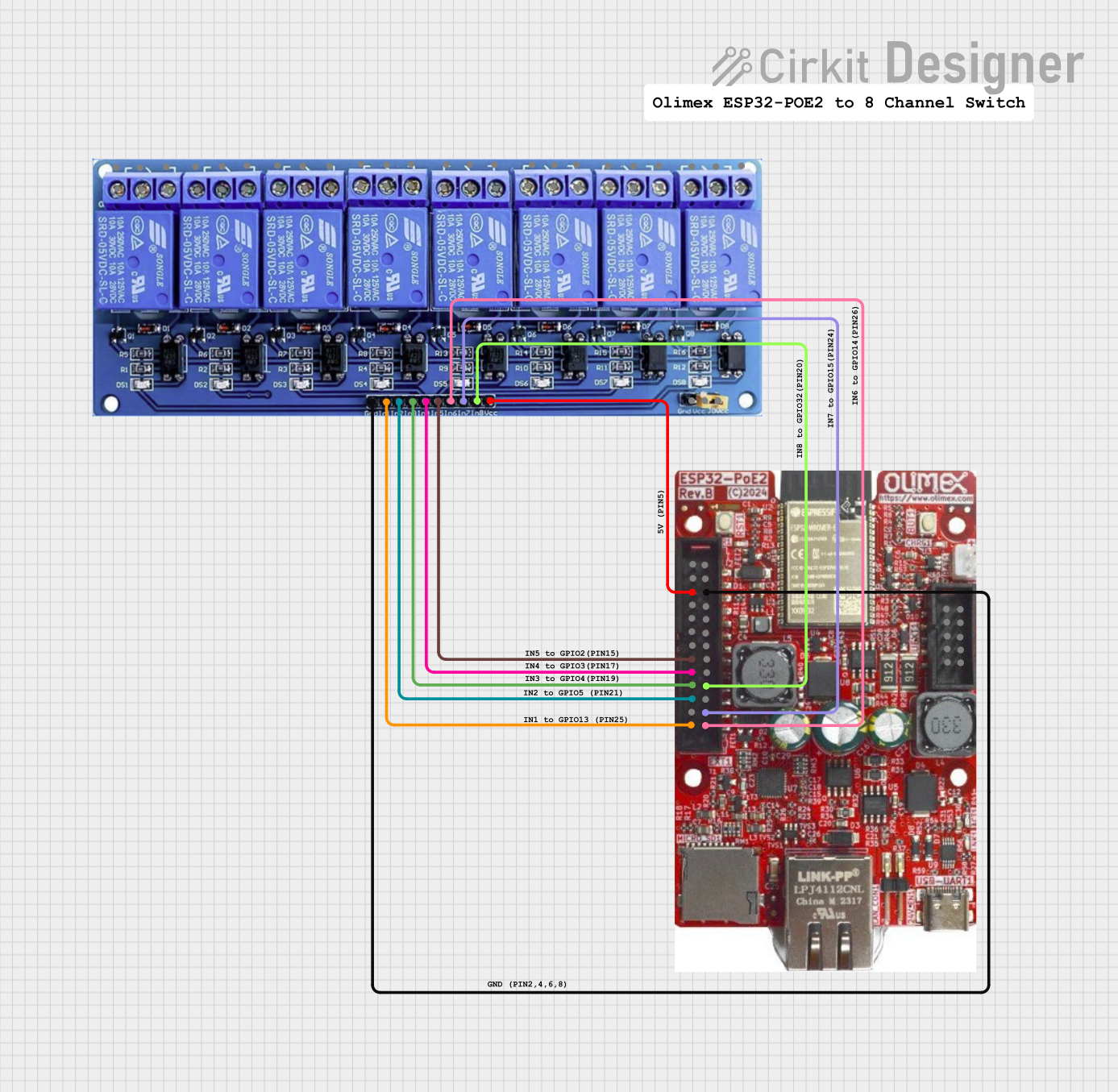
 Open Project in Cirkit Designer
Open Project in Cirkit Designer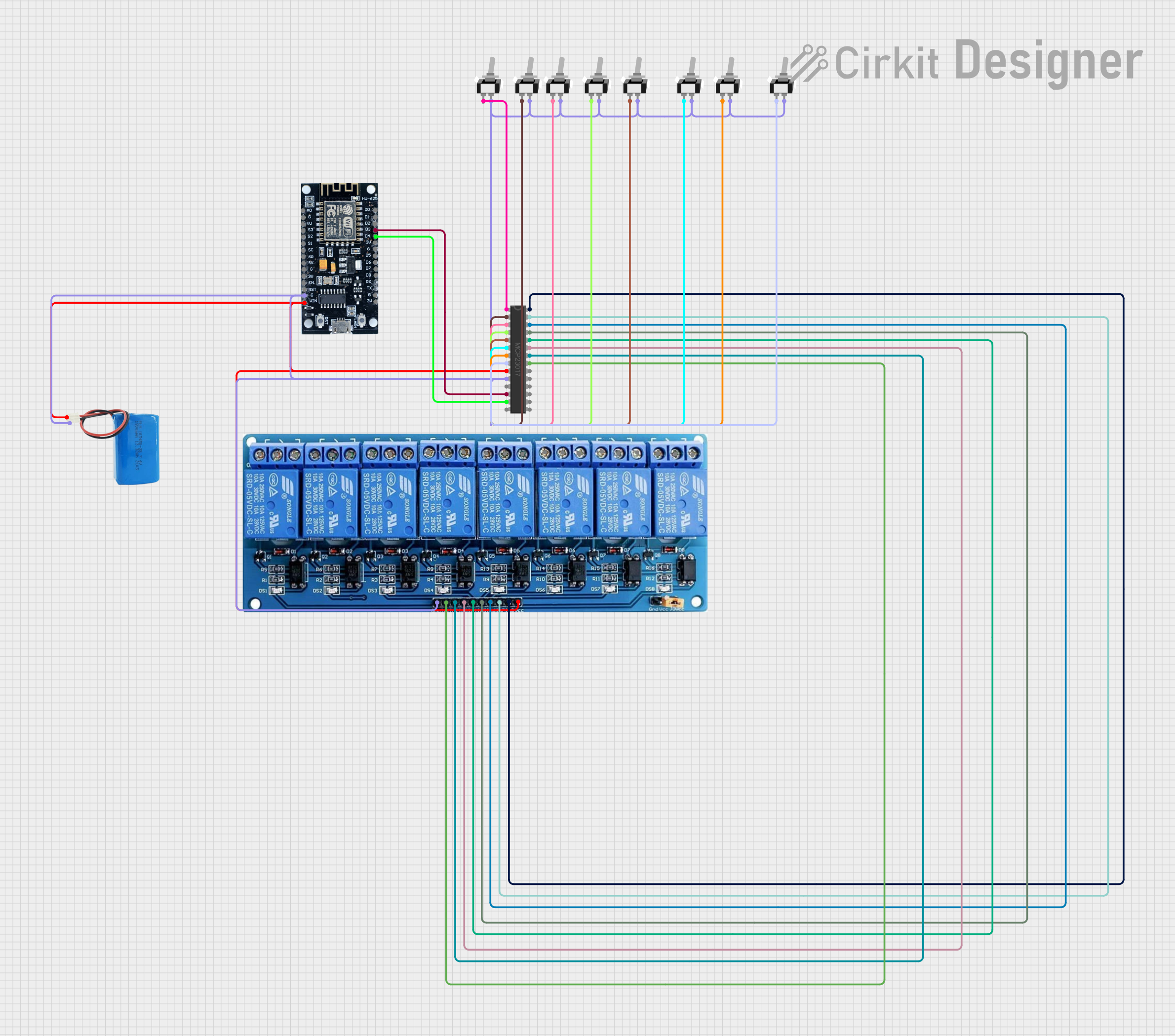
 Open Project in Cirkit Designer
Open Project in Cirkit DesignerExplore Projects Built with 8 Channel 5v Relay

 Open Project in Cirkit Designer
Open Project in Cirkit Designer
 Open Project in Cirkit Designer
Open Project in Cirkit Designer
 Open Project in Cirkit Designer
Open Project in Cirkit Designer
 Open Project in Cirkit Designer
Open Project in Cirkit Designer